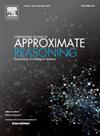成为贝叶斯就是从混合数据中学习贝叶斯网络
IF 3
3区 计算机科学
Q2 COMPUTER SCIENCE, ARTIFICIAL INTELLIGENCE
引用次数: 0
摘要
我们开发了一个新的贝叶斯模型来从混合数据推断贝叶斯网络的结构,即包含连续(高斯)和离散(分类)变量混合的数据。根据最先进的混合贝叶斯网络模型,我们不允许离散变量有连续的父变量。然而,我们的新模型不同于现有的方法,通过多元线性回归而不是混合建模纳入离散变量。在我们的模型中,连续变量遵循具有共享协方差矩阵的多元高斯分布,而平均向量在不同配置中变化。与所有贝叶斯网络模型一样,我们使用有向无环图(dag)来表示连续变量之间的条件依赖关系。对于我们的高斯分布,这要求协方差矩阵与DAG的结构一致。我们的关键思想是应用多元线性回归,使用离散变量作为潜在协变量来调整多元高斯分布的平均向量。每个连续变量都与自己的回归模型和离散父集相关联。由于离散变量的值在不同的观测值之间变化,因此平均向量是特定于观测值的。这使得连续变量对离散父变量的均值调整成为可能,同时推断出它们之间的高斯贝叶斯网络。在仿真研究中,我们将我们的新模型与两种最先进的混合贝叶斯网络模型进行了比较,并证明这两种现有模型都存在概念上的缺陷,将我们的新混合贝叶斯网络模型定位为一种强大的替代方案。本文章由计算机程序翻译,如有差异,请以英文原文为准。
Being Bayesian about learning Bayesian networks from hybrid data
We develop a new Bayesian model to infer the structure of Bayesian networks from hybrid data, that is, data containing a mix of continuous (Gaussian) and discrete (categorical) variables. In line with state-of-the-art hybrid Bayesian network models, we do not allow discrete variables to have continuous parents. However, our new model differs from existing approaches by incorporating discrete variables through multivariate linear regression rather than mixture modeling. In our model, the continuous variables follow a multivariate Gaussian distribution with a shared covariance matrix, while the mean vector varies across different configurations.
As with all Bayesian network models, we use directed acyclic graphs (DAGs) to represent conditional dependency relations among the continuous variables. For our Gaussian distribution, this requires the covariance matrix to be consistent with the structure of the DAG. Our key idea is to apply multivariate linear regression, using the discrete variables as potential covariates to adjust the mean vector of the multivariate Gaussian distribution. Each continuous variable is associated with its own regression model and discrete parent set. Since the values of the discrete variables vary across observations, the mean vector becomes observation-specific.
This enables mean-adjustment of the continuous variables for their discrete parents while simultaneously inferring a Gaussian Bayesian network among them. In simulation studies, we compare our new model against two state-of-the-art hybrid Bayesian network models and demonstrate that both existing models have conceptual shortcomings, positioning our new hybrid Bayesian network model as a strong alternative.
求助全文
通过发布文献求助,成功后即可免费获取论文全文。
去求助
来源期刊

International Journal of Approximate Reasoning
工程技术-计算机:人工智能
CiteScore
6.90
自引率
12.80%
发文量
170
审稿时长
67 days
期刊介绍:
The International Journal of Approximate Reasoning is intended to serve as a forum for the treatment of imprecision and uncertainty in Artificial and Computational Intelligence, covering both the foundations of uncertainty theories, and the design of intelligent systems for scientific and engineering applications. It publishes high-quality research papers describing theoretical developments or innovative applications, as well as review articles on topics of general interest.
Relevant topics include, but are not limited to, probabilistic reasoning and Bayesian networks, imprecise probabilities, random sets, belief functions (Dempster-Shafer theory), possibility theory, fuzzy sets, rough sets, decision theory, non-additive measures and integrals, qualitative reasoning about uncertainty, comparative probability orderings, game-theoretic probability, default reasoning, nonstandard logics, argumentation systems, inconsistency tolerant reasoning, elicitation techniques, philosophical foundations and psychological models of uncertain reasoning.
Domains of application for uncertain reasoning systems include risk analysis and assessment, information retrieval and database design, information fusion, machine learning, data and web mining, computer vision, image and signal processing, intelligent data analysis, statistics, multi-agent systems, etc.
 求助内容:
求助内容: 应助结果提醒方式:
应助结果提醒方式:


